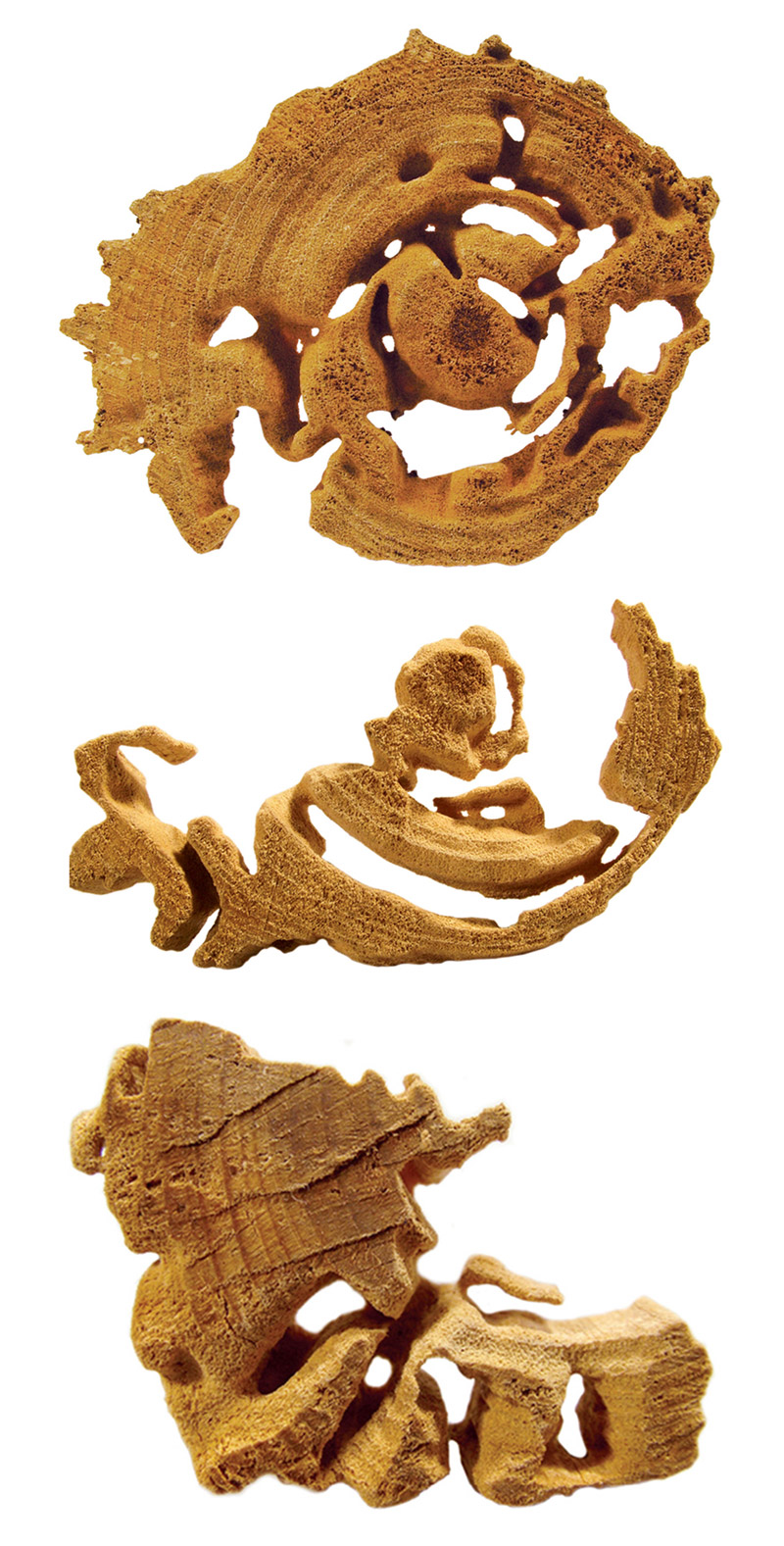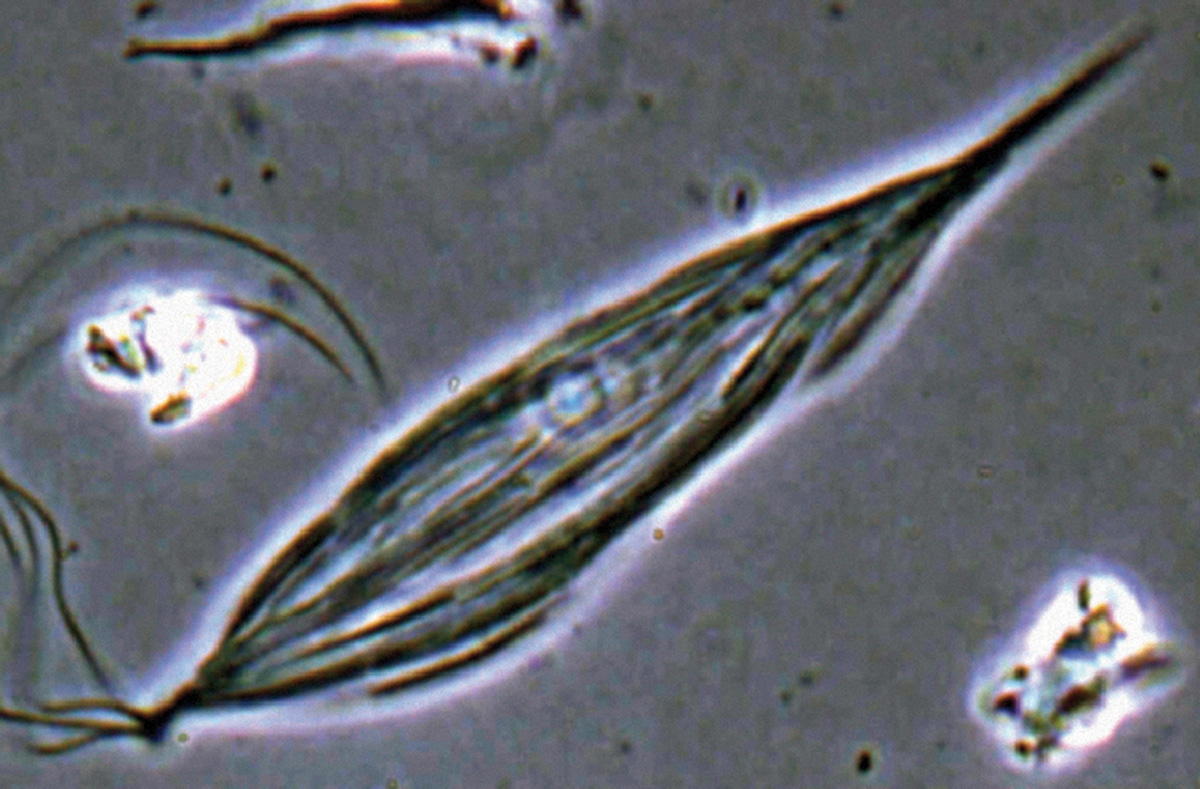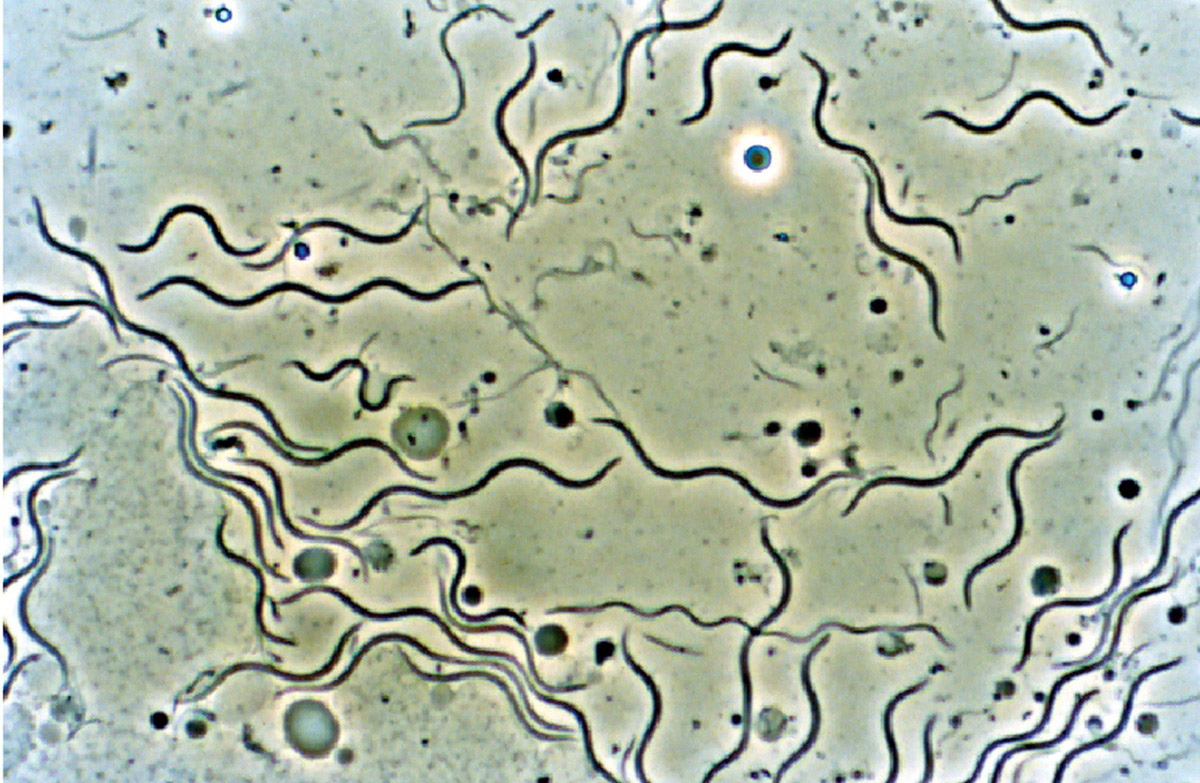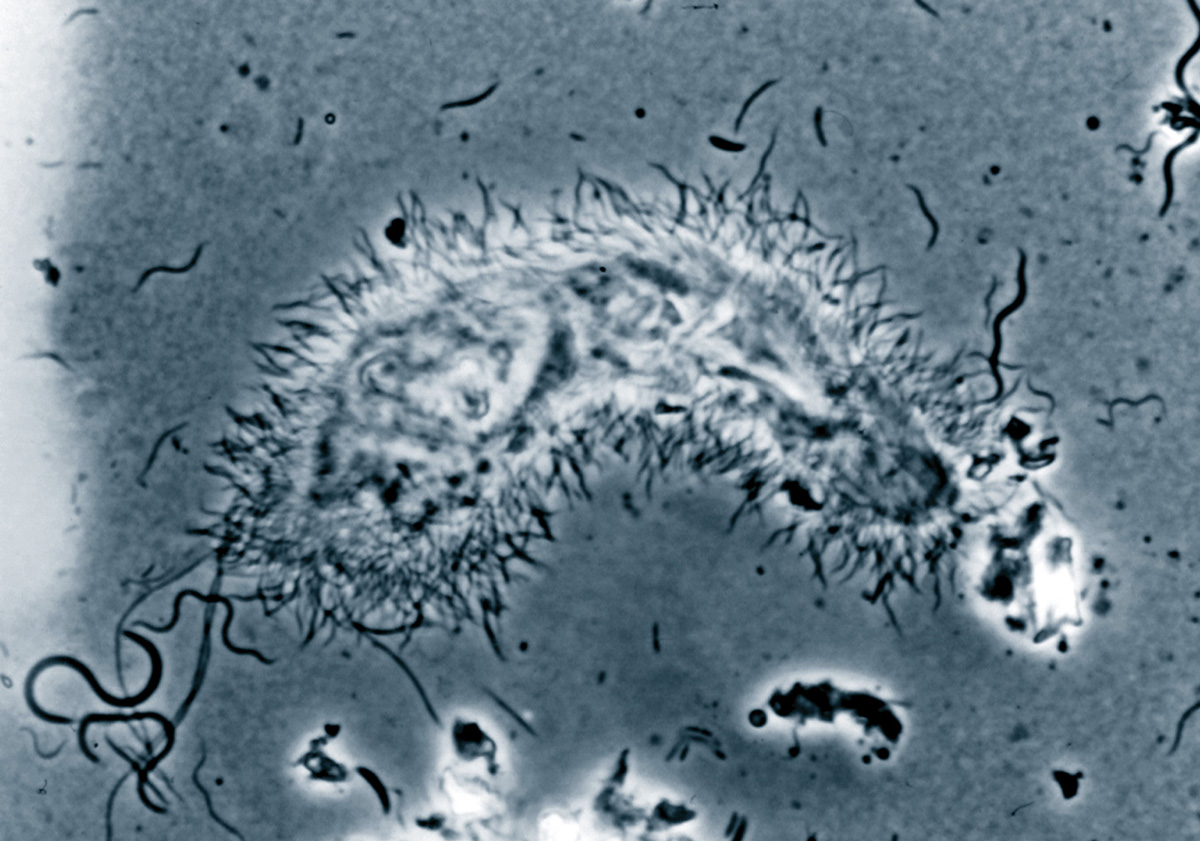The Ecology of the Termite Gut: An Interview with Jared Leadbetter
Chowing down the house
Margaret Wertheim and Jared Leadbetter
Few organisms strike fear into the hearts of homeowners more than the humble termite. From the order Isoptera, termites are estimated to cost the California economy more than a billion dollars a year, and their ubiquitous presence has given rise to that curious genre of wrapped objects—the tented home. Though fearsome in one’s foundations, termites’ penchant for wood should also command our respect insofar as it is one of the linchpins of the global ecology. Around the world, some twenty-six hundred species of termites quietly break down the vast tonnage of fallen trees and other fibrous biomass, digesting lignin and cellulose and recycling forest nutrients. They can do so because of the unique colonies of microbes that live inside their guts. These unheralded communities daily perform a miracle of micromolecular transformation that cleanses our planet and keeps our environment healthy.
Among the microbes are spirochetes, related to the bacteria that cause syphilis, and tiny protozoans that recall marine mammals—one called Trichonympha has an aquiline body suggestive of microscopic sea lions. This interlocking ecology, whose members chart their way by sensing chemical gradients in the liquid around them (a process known as chemotaxis), has collectively evolved the ability to break down even the hardest woods. How they do so is still largely unknown, but it is a trick that industry would love to learn. In theory, understanding termite gut ecology may hold the key to efficient production of biofuels. Dr. Jared Leadbetter, associate professor of microbiology at Caltech’s Department of Environmental Science and Engineering, is a world expert on termite gut ecology. In June 2006, he gave a talk on the subject at The Institute For Figuring in Los Angeles. IFF Director, Margaret Wertheim, interviewed him earlier this year in his Caltech lab.
Cabinet: To most non-scientists a termite gut sounds like a pretty esoteric subject. How did you get into this?
Jared Leadbetter: I have been interested in insects since I was a little kid, even before I was in kindergarten. After my junior year at Goucher College, I had the opportunity to take a summer course at the Wood’s Hole Marine Biological Laboratory. A few weeks into the course, we looked at the termite gut microbiota, and I was totally blown away. The visual impact of these organisms was just astonishing to me—I was totally shocked. A lot of these organisms have bizarre shapes and forms. Both their overall appearance and the way they move were scintillating to me, and so I asked the instructor—John Breznak—a lot of questions. Some he could answer, but he made it clear that many of the questions he had no idea how to answer. I decided that I really wanted to study termite gut microbes for my graduate work, and he became my Ph.D. advisor.

Did you want to study this because you felt it was interesting, or were there more practical reasons too?
It’s a mixture. As someone who does basic research, an element of it is that I just find these organisms fascinating. How do the insect and its gut microbes interact with one another to carry out something that you and I are unable to do, which is to degrade wood? At the same time there is real-world significance in this work. I think it’s important for society to understand how biomass is made and how forests grow; how do plants make new biomass and how does that impact on food webs? A corollary is that it’s also important to understand where that biomass goes. When plants die, when trees die, what is the ultimate fate of the wood? Termites are one of the organisms that play a key role in our planet, turning dead plant material into other forms of useful energy, and it’s important for us to understand these processes.

What do termites do that other creatures can’t do?
Termites belong to a group of somewhat unrelated animals that have each come up with solutions to a problem, namely how to degrade wood and derive nutrition from wood. Obviously cows and goats and sheep can degrade grass, and we’re unable to do that, but termites are able to degrade wood, which to my knowledge no mammal can do. There are at least three groups of invertebrate animals that can do this: termites; marine bivalves that are relatives of clams, such as the shipworm; and certain beetle larvae. All these groups have solved the problem of wood degradation by forming a symbiotic relationship with different microbes—the microbes are the ones that actually break down the wood.
If you are a microbe, you are very, very small—you don’t have a mouth, you don’t have hands, and you don’t have utensils; you’re really challenged by the problem of eating something larger than your head. If you want to eat a blade of grass or a very large log, it’s hard to get access to that cellulose because you are so small. So if I am a termite or one of these bivalves, I can provide the microbe with a service—strong jaws that can grind up the wood into very small pieces that are more on the order of the size of the microbe, or a clamshell that can be used to scrape away wood particles. So the microbe benefits from the relationship, but the animal also benefits because the microbes break down that wood and some of the chemical by-products of degradation are shared with the host animal. The microbes essentially feed the animal.

Another way in which the microbe helps the animal is that wood is a very poor source of protein—it’s carbon-rich but protein-poor. So even if you or I were able to degrade wood, it wouldn’t be that different from eating paper—lots of energy but not a lot of protein. One of the things you find in termites are bacteria that are able to take in atmospheric nitrogen—a process called nitrogen fixation—and turn that into protein. Most higher organisms, including mammals, can’t use nitrogen directly from the air and rely on microbes that form symbiotic relationships with legumes such as soy beans to do this for us. In termites, we also find bacteria that convert atmospheric nitrogen into protein-level nitrogen, so they relieve a natural nutrient limitation that is really quite formidable.
Nitrogen fixation is one of the most important chemical processes in the entire chain of life, since nitrogen is essential for making proteins and nucleic acids. So you’re saying that these termite microbes are part of the nitrogen cycle as well?
Yes, that’s right. These microbes help to convert atmospheric nitrogen to a form that can be used by the termites to build critical organic chemicals—then when the termites die or get eaten by other animals, that fixed nitrogen trickles up the food chain. Ultimately, life on earth is limited by the amount of nitrogen available, so any organism that fixes nitrogen is doing us all an invaluable service.
On the world scale, how important are termites?
Termites globally are a very important group of animals. They play a central role in the ecology of many tropical and subtropical ecosystems. One way of gauging their significance is by how abundant they are. There are somewhere between 1015 and 1017 termites on earth. There are only 109 humans, so there are between a million to a hundred million termites for every one of us. The science of counting termites is inexact—but even at the most conservative estimate, there are quite a few pounds of termites per person on earth.
How many?
Depending on what estimates you use, it can range from twenty pounds on up. But you can also judge the importance of termites by what they do. They convert enough plant material to emit around 2 percent of global carbon dioxide. If you think of all the fossil fuels that are burned, you see how active termites are in “burning up,” so to speak, wood and emitting it as carbon dioxide. For any group of animals, that’s a pretty astonishing feat.
Of course termites aren’t contributing to global warming—they are just recycling carbon dioxide as part of the natural cycle that makes it available for new generations of plants to grow. But it is an astonishing figure. How do you think we might apply an understanding of termite gut ecology?
In the past few years, there’s been a lot of discussion about what some call biofuels—biologically produced energy substrates we might tap, such as hydrogen, methane, or ethanol. Currently we have an understanding of how to convert cornstarch into ethanol, and this is done in the Midwest on a fairly significant scale. In Brazil, there’s also a formidable infrastructure for converting sucrose into ethanol. Yet both sugar and cornstarch can be considered food, and there’s a debate about whether converting food into bioenergy is the route we should go when there are other lower value commodities that might be used. If you think about sugarcane, for example, you squeeze out the sucrose and convert that to ethanol, but what happens to all the stalks and leaves that are left over? Not much, it turns out, because there is no similar process to convert this enormous amount of leftover material. What about cornhusks? Or rice hulls? It would be good if we could convert these into biofuels, but the limitations of doing this are at a very basic level because we really don’t know how to degrade these materials. By understanding how termite gut microbes do it, we might be able to tap this natural toolbox for industrial applications.
How many species of termite gut microbes are there?
Any one termite contains on the order of two hundred unique species of microbe, bacteria, and protozoa—about two hundred species that you don’t find anywhere else in nature. So they are a hot spot of diversity. You have in a microliter of fluid a very tiny, yet complex, ecosystem, and one of the things we are trying to understand is how all those organisms are interacting with each other to degrade the substrate and to feed the termite.
What have you discovered so far?
One of the focuses in my laboratory has been not on the degradation of the wood per se but on what the wood is turned into. One of the major products of wood decay in the guts of termites is hydrogen gas, which is what filled the Hindenburg airship. That explosive, energy-rich gas is generated as a key intermediate in termites; then, instead of the gas exploding or catching on fire, other organisms in the termite gut tap this hydrogen and do work with it, so to speak. One of these other microbe groups can fix carbon dioxide, which means they take carbon dioxide and combine that with hydrogen to make acetate, essentially acetic acid or vinegar. It’s this acetate that’s absorbed by the insect and used as its major source of energy. So termites don’t gain their nutrition from wood directly; they’re basically using acetate, much of it derived from hydrogen gas and carbon dioxide.

With two hundred different microbes, that suggests there must be a lot of different chemical steps going on. It sounds like a complex process.
It is, and one of the reasons is that the hindgut of a termite is an anaerobic environment—not only do the microbes living there not use oxygen, they hate oxygen and are poisoned by it. There are many environments on earth that operate in the absence of oxygen, and one of the patterns that has been understood in the last forty or fifty years is that in these environments biodegradation proceeds in many more steps than it does in the aerobic or the oxygen-filled world. There’s much more partitioning of functions in these oxygen-free zones so that certain organisms will do certain things and make products that are then used by other organisms. We use the term “the anaerobic food web” to describe this. The process of nitrogen fixation is at its core a reaction that abhors oxygen; so much of our protein is ultimately derived from anaerobic processes.
A large part of the history of Earth has been dominated by oxygen-free life, and today there are many, many environments devoid of oxygen that are the homes of diverse microbes. In terms of symbiosis, this has a huge benefit for the insect because in oxygen-free metabolism, the degradation of wood yields products that remain energy-rich. If you think of ethanol being produced by yeast from grape sugar, anaerobes will not use all the energy in the substrate, and so products like ethanol or acetate or hydrogen can be used by other organisms such as termites or cows or by us as a source of energy. Through symbiosis with anaerobic microbes, termites ultimately get a lot more energy from wood than they otherwise might have.
How long do you think it might take to understand this process so that we could apply it for our own purposes?
I like to tell people that what we need if we want to have this happen anytime soon is a Manhattan Project for biofuels. It’s going to take that type of commitment. I’m not a nuclear physicist, but my feeling is that probably nuclear physics was substantially more mature a field at the onset of the Manhattan Project than our biofuel efforts are now—and we haven’t yet been told there is going to be a Manhattan Project for biofuels.
We use a lot of energy in this country and globally, and it’s going to be very hard to replace the energy we derive from fossil fuels with any other form. Solar energy, which is what plants are making material from, is one source that might be tapped. So when you look at any process that can derive biofuels from plant material, you are really looking at a coupled solar process. It’s a very formidable task to understand this, and it’s not going to be easy to solve. If we are serious about biofuels, we really need a long-term commitment to the basic scientific research before we can really begin to think about industrial applications.
Do you see other applications apart from fuels?
One of the things that makes a termite interesting is that per mouthful of plant biomass, termites emit far less methane than cows. Cows are a significant source of global methane, which is a potent greenhouse gas. Anything that could curb methane emissions by domesticated animals could have an impact on our global greenhouse gas budget. Now methane is a product of the metabolism of certain microbes—along with hydrogen and acetate—and the methane that termites and cows emit is not of nutritional value to the animal host, so it’s effectively lost calories. In termite guts, the microbes that convert hydrogen and carbon dioxide into acetate compete with other microbes that make methane, so by understanding the basis for this competition we might potentially be able to tweak the fermentations that occur in the guts of domestic animals like cows. The idea is that we might alter the mix of microbes in the cow’s gut. This could not only cut down on methane emissions and help our greenhouse gas problem; it would also give the cows more nutritional content from their feed.
I have to ask you one question. Like me, you live in Los Angeles; do you have termites in your house?
Everyone who has a wooden home in Los Angeles has a termite infestation. Regardless whether you have had your home tented a year ago, or twenty-five years ago, they have infested your house to one degree or another.
Jared Leadbetter, associate professor of microbiology at Caltech’s Department of Environmental Science and Engineering, is a world expert on termite gut ecology.
Margaret Wertheim is founder and director of the Institute For Figuring, a Los Angeles-based organization dedicated to the aesthetic and poetic dimensions of science and mathematics. She is currently working on a book about outsider physics and the role of imagination in theoretical science.